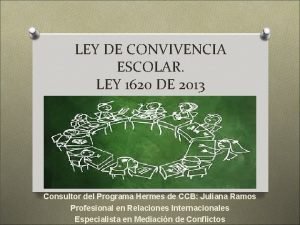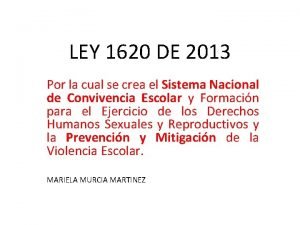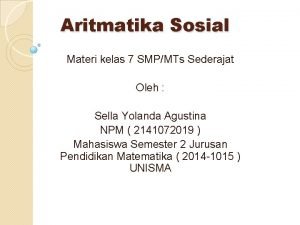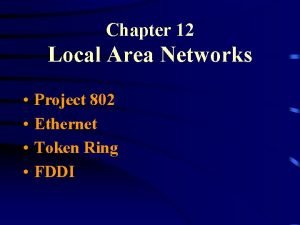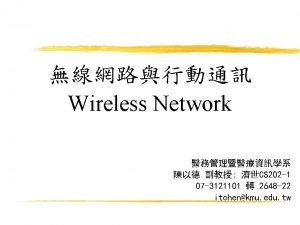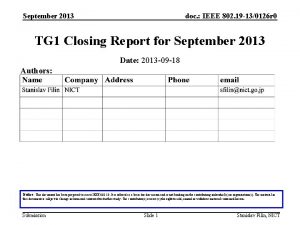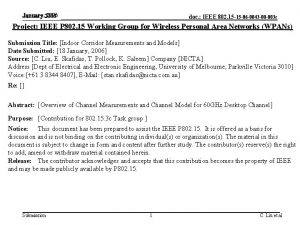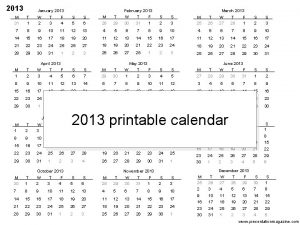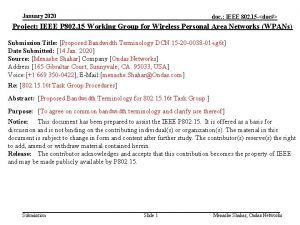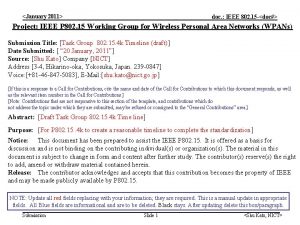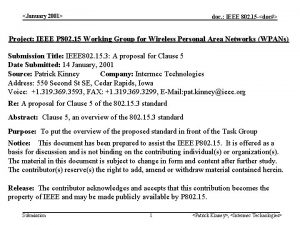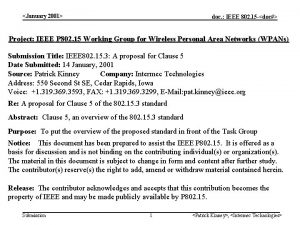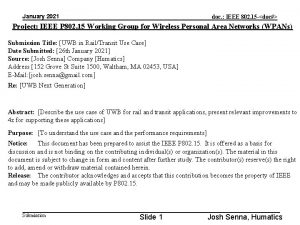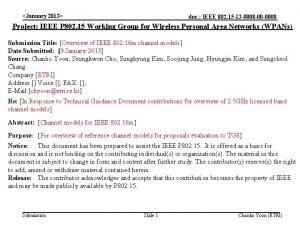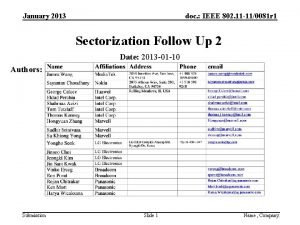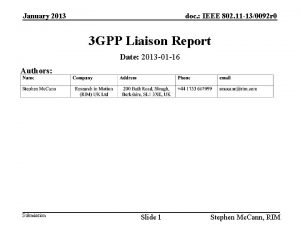January 2013 doc IEEE 802 11 130126 r
















- Slides: 16

January 2013 doc. : IEEE 802. 11 -13/0126 r 3 802. 11 mc HEMM Authors: Submission Date: 2013 -01 Slide 1 Graham Smith, DSP Group

January 2013 doc. : IEEE 802. 11 -13/0126 r 3 Abstract This document contains a discussion and proposals relating to CID 148 What is HEMM anyway? What does "HCCA, EDCA mixed mode" mean? Which elements of HCCA and EDCA are used in HEMM? Submission Slide 2 Graham Smith, DSP Group

January 2013 doc. : IEEE 802. 11 -13/0126 r 3 HEMM • Defined as “HCCA, EDCA Mixed Mode” • Appears only 6 times in 11 e but a lot more in 802. 111012 • 2 Major places in Specification: – Table 8 -5 TID • 8 -15 is used for HCCA • 8 -15 is also used for HEMM • (So no way to differentiate) – Access Policy in TS Info Field • 11 = HEMM • 01 = HCCA • THIS IS THE ONLY DIFFERENTIATION IN THE SPEC Submission Slide 3 Graham Smith, DSP Group

January 2013 doc. : IEEE 802. 11 -13/0126 r 3 HEMM • TS Operation 10. 4. 1 – Access Policy “to modify the HC’s scheduling behavior”. – A TSPEC request may be set so that both HCCA and EDCA mechanisms (HEMM) are used. ” Q. How does a TSPEC specify both HCCA and EDCA mechanisms? ANS. By setting Access Policy to 11. Submission Slide 4 Graham Smith, DSP Group

January 2013 doc. : IEEE 802. 11 -13/0126 r 3 HEMM – Last Para 9. 19. 3. 5. 1 Edited by me for clarity “HCF contention-based channel access shall not be used to transmit MSDUs belonging to an established TS (with the HC’s acceptance of the associated TSPEC), unless: • the granted TSPEC indicates it is permitted to do so when the Access Policy subfield of the TS Info field is equal to “HCCA, EDCA mixed mode” (HEMM), • the polled STA utilized the full TXOP provided by the HC, and it has more MPDUs to send. “ Discussion on this: If there is a HCCA time slot allocated then the MSDUs must use it – that seems reasonable BUT it stipulates that an TS cannot transmit using EDCA at all if the TSPEC is for HCCA. If TSPEC is for HEMM then TS can use EDCA for any ‘surplus’ packets but only if time slot is totally used up. So, if TSPEC is HEMM, then excess packets can be sent using EDCA If TSPEC is HCCA, then excess packets can not be sent using EDCA. This raises the question of EDCA Admission Control if the AC has ACM bit set. Submission Slide 5 Graham Smith, DSP Group

January 2013 doc. : IEEE 802. 11 -13/0126 r 3 HEMM – Last Para 9. 19. 3. 5. 1 cont. “When this QSTA sends frames belonging to a TS using contention-based channel access, it shall encode the TID field in the Qo. S Data frame with the TID associated with the TS. “ OK, no problem here, irrespective of HEMMS When the QAP grants a TSPEC with Access Policy subfield set to HEMM and if the corresponding AC needs admission control, the QAP shall include the Medium Time that specifies the granted time for EDCA access in the ADDTS response frame. ” So, IF ACM BIT SET, the AP returns a “Medium Time” for HEMM. Question: • What is value of the Medium time? It is only for “excess traffic” so no real way of knowing what is required. Simple is to return a Medium Time equal to the values used in the TSPEC but his would be inefficient. Submission Slide 6 Graham Smith, DSP Group

January 2013 doc. : IEEE 802. 11 -13/0126 r 3 So what is HEMMS? • HEMMS is identified in a TSPEC by setting the Access Policy to 11. The TID is set same as HCCA. • HEMMS is set in the TSPEC so that the STA can send surplus packets outside the time slot. • A HEMMS TSPEC response will includes Medium Time, if AC has ACM set. • Questions • “Do we need HEMM in addition to HCCA, or should we allow HCCA similar access to EDCA? ” • “Why would an HCCA STA ever not select HEMMS? Hence, why do we need two schemes? Submission Slide 7 Graham Smith, DSP Group

January 2013 doc. : IEEE 802. 11 -13/0126 r 3 Keep HEMMS? • So HEMMS seems to be a way to protect an AC with ACM if there are surplus packets. When does this problem arise and is it a big enough problem? Problem arises if traffic exceeds the Time Slot allocation How often? How much? More likely to be a problem for Video (VBR) and not a problem for voice or audio (CBR) unless the medium gets blocked. As the medium is always possible to be blocked, one could argue that HCCA should never be used, and only HEMM makes any sense. If so, why have two schemes? I personally cannot see any need for both schemes as HEMM has the back up that would be silly to not have. Submission Slide 8 Graham Smith, DSP Group

January 2013 doc. : IEEE 802. 11 -13/0126 r 3 If we keep HCCA and HEMMS • Need to clarify how the Medium Time is calculated and to make clear if required if no AC has ACM bit set. – Annex N could cover this – What should the value of the Medium Time be? A proportion? The full amount? Even if one time slot is blocked, as Medium Time is calculated over a 1 second period, still not easy to work out what proportion it should be. Also it should be small as only used if the TSPEC ‘got it wrong”. (Would this effect the admission policy calculation – HIGHLY UNLIKELY) – Should the STA be encouraged to modify its TSPEC if it finds itself having significant “excess” packets? No need if HEMM. SO why use HCCA ever, if HEMM provides this safe haven? why have two schemes? Is the only real reason to keep both is so that the term “HEMM” can be used (If HCCA did not exist, the “H” cannot be used) Submission Slide 9 Graham Smith, DSP Group

January 2013 doc. : IEEE 802. 11 -13/0126 r 3 Just have HCCA • Simply allow HCCA to spill over into EDCA in the case that there are surplus packets. • We have argued that there is no practical reason why any TSPEC would restrict itself to HCCA only and the safe path is always to set HEMM as the Access Policy. Questions • Do we still need a Medium Time in the ADDTS Response? Note – only required if AP supports HCCA AND EDCA Admission Control. – NO - If ACM bit set, simply allow excess packets to use AC on the assumption that this is a rare event. Remember TSPECs are pessimistic. Also if ACM not set, no problem, not needed. – YES - Have a Medium Time so that STA can test its Used Time. What Medium Time? How much? Does it make any difference to ACM access? Submission Slide 10 Graham Smith, DSP Group

January 2013 doc. : IEEE 802. 11 -13/0126 r 3 HEMM – would we miss it? In my opinion, NO • no one would miss it. • No need for two schemes for HCCA Mark H has indicated that a STA could cheat EDCA Admission Control by sending a ‘small’ HCCA TSPEC and then using the ACM AC. Whether this is a real benefit as STA must still must use time slot, has a CFP allocation to itself, so why deliberately move over to a contention channel and get less efficiency? BUT, worthy of consideration so please see Proposal B Submission Slide 11 Graham Smith, DSP Group

January 2013 doc. : IEEE 802. 11 -13/0126 r 3 Further Discussion and Argument • • HCCA STAs best interest to send all its traffic during the CFP – it is way more efficient and safer compared to EDCA (latency, etc) – hence what is incentive for the STA to cheat and simply use EDCA ACM access when it can get CFP? However, even in the case of the HCCA STA using the time slot, the possibility of interference is always present, so restricting the HCCA STA in any way could be dangerous. So, if both options, the STA would still be better to ‘play it safe’ and use HEMM just in case. If the AP is not using EDCA Admission Control, then there is no disadvantage at all to selecting HEMM. If the AP is using EDCA Admission Control, i. e. VO and VI are set to ACM, as well as HCCA Admission Control, then the disadvantage is only for the AP in that it now needs to grant some bandwidth in the form of Medium Time (as it stands at the moment). The STA now has to not only service the time slot allocations but should, in theory, also keep account of its EDCA Used Time (I very much doubt if in practice it would, but in theory and to meet the Standard, it should). Submission Slide 12 Graham Smith, DSP Group

January 2013 doc. : IEEE 802. 11 -13/0126 r 3 Discussion and Argument • • Proposal for HCCA only with no medium time is to keep it simple. How often an HCCA QAP would use EDCA Admission Control is unknown, and theoretically zero, the overall bandwidth allocation for the AP is almost certainly covered by the HCCA TXOP allocation Given the choice of HCCA or HEMM a STA would and should always choose HEMM as it is “fail safe”, hence it does not make sense to have two schemes. The argument for keeping both HCCA and HEMM is that it is the status quo and what if a TSPEC is send with Access Policy 11 (HEMM). One solution is to simply use 01 and 11 for HCCA, Proposal to keep both still needs agreement on the Medium Time recommendation for HEMM, and I suspect that may be hard and possibly subject to many comments whatever value is chosen. But a Medium Time recommendation cannot be ignored as it certainly is a gap in the Standard. Submission Slide 13 Graham Smith, DSP Group

January 2013 doc. : IEEE 802. 11 -13/0126 r 3 Proposal A • Remove all references to HEMM in the Standard – 01 and 11 Access Policy both refer to HCCA in order to cover legacy and backward compatibility. • Rewrite the last para of 9. 19. 3. 5 as follows: “HCF contention-based channel access shall not be used to transmit MSDUs belonging to an established TS (with the HC’s acceptance of the associated TSPEC), unless the polled STA: · Utilized the full TXOP provided by the HC, and · At the completion of the TXOP provided by the HC the STA has more MPDUs to send. If both these conditions have been met, this STA may transmit MPDUs belonging to an established TS using contention-based channel access, irrespective of the value of the ACM bit in the corresponding access category. When this STA sends frames belonging to a TS using contention-based channel access, it shall encode the TID subfield in the Qo. S Data frame with the TID associated with the TS. If the STA transmits MSDUs belonging to an established TS using contention based channel access, the STA should request modification of the associated TSPEC to an HCCA schedule that allows this TS to be serviced entirely using TXOPs in a CFP. ” Submission Slide 14 Graham Smith, DSP Group

January 2013 doc. : IEEE 802. 11 -13/0126 r 3 Proposal B • Retain HEMM in the Standard • Leave the last para of 9. 19. 3. 5 as is except last sentence: “When the AP grants a TSPEC with the Access Policy subfield equal to HEMM and if the corresponding AC needs admission control, the AP shall include the medium time that specifies the granted time for EDCA access in the ADDTS Response frame (see Annex N 2. 2). ” • Add text to Annex N 2. 2 that provides some recommendations on what the Medium Time field should be in this case. “N. 2. 2. 1 HEMM Medium Time When the AP grants a TSPEC with the Access Policy subfield equal to HEMM and if the corresponding AC needs admission control, it is recommended that the medium time that is included in the ADDTS Response frame has a value that is 1/10 th of the value that is derived using the procedure described in N 2. 2” Note: the 1/10 th value is open to discussion but what should it be? Submission Slide 15 Graham Smith, DSP Group

January 2013 doc. : IEEE 802. 11 -13/0126 r 3 Poll • Proposal A or Proposal B? Submission Slide 16 Graham Smith, DSP Group
 Bridges from 802.x to 802.y
Bridges from 802.x to 802.y Bridges from 802.x to 802.y
Bridges from 802.x to 802.y Ieee 802 family
Ieee 802 family Ieee 802 3 compliance
Ieee 802 3 compliance Wlan standards
Wlan standards Arquitetura ieee 802
Arquitetura ieee 802 Estandares ieee 802
Estandares ieee 802 Ieee 802 standard
Ieee 802 standard Bluetooth ieee 802
Bluetooth ieee 802 802 ieee
802 ieee Ieee 802
Ieee 802 Ley 1620 del 2013
Ley 1620 del 2013 Ley 1620 de 2013 situaciones tipo 1 2 y 3
Ley 1620 de 2013 situaciones tipo 1 2 y 3 Materi aritmatika sosial kelas 7 kurikulum 2013
Materi aritmatika sosial kelas 7 kurikulum 2013 802 5
802 5 802*12
802*12 802 family
802 family











